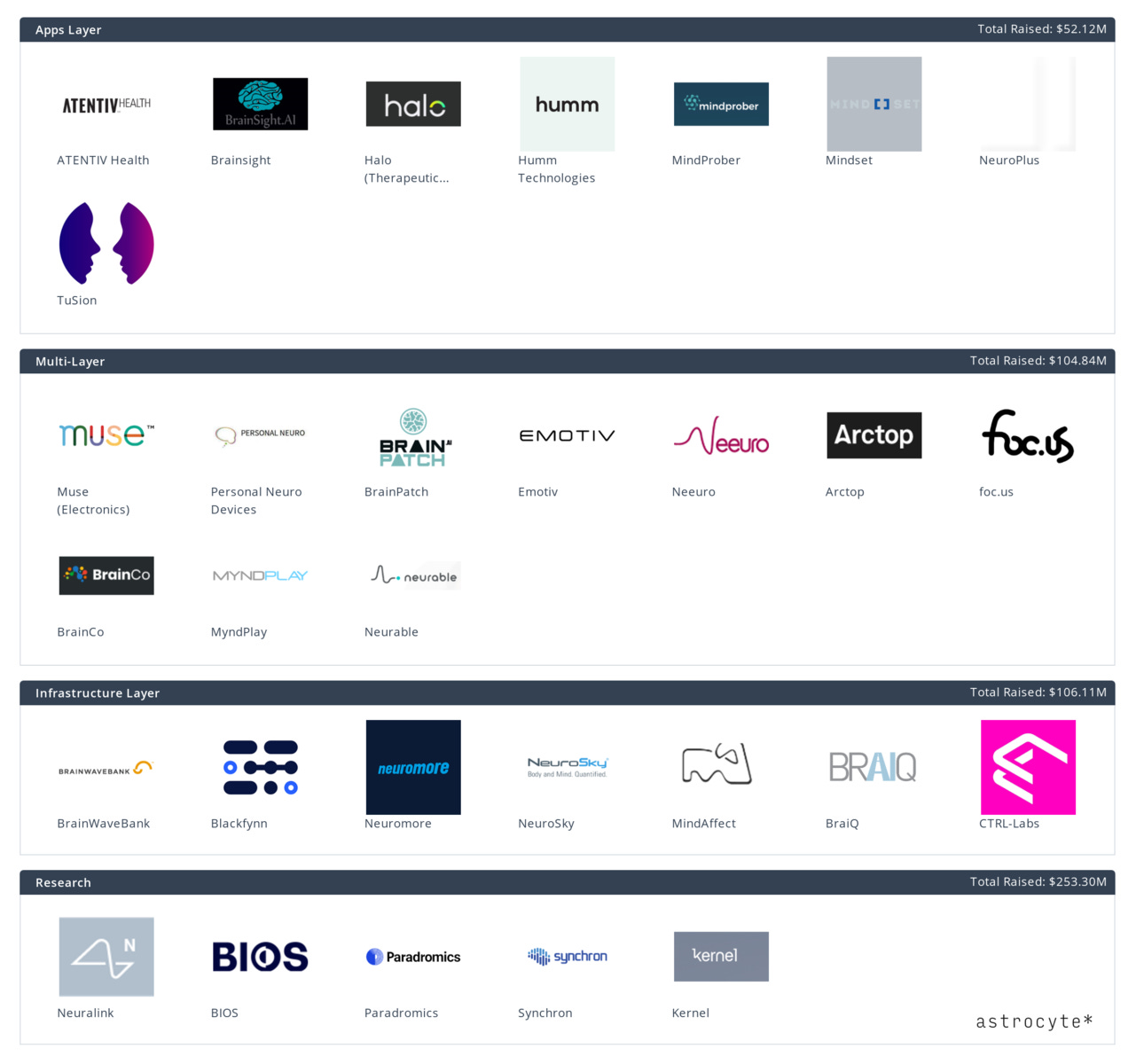Neurotech monthly. April 2021
Ultrasound, brain-to-text BCI, synthetic data for neuroscience, Peter Thiel invests in neurotech
The first issue of astrocyte* newsletter is here. Thank you all who subscribed even before it went live, appreciate your trust and hope you’ll like it.
The newsletter has two parts:
- My neurotech reading list with some comments/interpretations and attempts to link it to a wider tech ecosystem, patterns, trends, etc.;
- Monthly neurotech investment activity review.
🕊🕊🕊 Share with others for helping me to collect more feedback, links, comments, and improve the newsletter.
Thanks!
***
I. Reading List
Tech Stack
A review of classification algorithms for EEG-based brain–computer interfaces: a 10 year update. Among other things, the article highlights importance of feature extraction and selection, development of classification methods specific to EEG-based BCIs, also explains why DNNs application is limited (data availability, computational complexity leading to long calibration).
Takeaways/interpretations
- BCIs present a challenging case for data-collection (low signal-to-noise ratio signal non-stationarity over time, within or between users), not clear how startups can collect this data at scale;
- On the flip-side, tech incumbents (FB, Google, etc.) do not have the data advantage, so an opportunity for startups is here;
- Custom/BCIs-specific chips will probably emerge.
Reading Minds with Ultrasound: A Less-Invasive Technique to Decode the Brain's Intentions. The tech reads out brain activity corresponding to the planning of movement via functional ultrasound (fUS) technology, maps brain activity from precise regions deep within the brain at a resolution of 100 micrometers (the size of a single neuron is approximately 10 micrometers).
Takeaways/interpretations
- Being minimally invasive this tech may have a wider adoption;
- It also has some potential for miniaturisation (see Butterfly IQ), again wider adoption.
Researchers demonstrate first human use of high-bandwidth wireless brain-computer interface - ‘… an intracortical wireless BCI with an external wireless transmitter. The system is capable of transmitting brain signals at single-neuron resolution and in full broadband fidelity without physically tethering the user to a decoding system’.
Takeaways/interpretations
- It enables to look at brain activity at home, over long periods in a way that was nearly impossible before, when participants had to be in a lab;
- There will be a need for more tech that connects BCIs to a wider tech stack. A similar patter was seen before. The better/more powerful a pice of tech is, the more important is its connectivity to the stack. For example, Intel paid hundreds of millions for tech to enable chip-to-chip as well as server interconnects.
Philosophy/Ethics
Do Brain Implants Change Your Identity? The article provides a great account of personal and ethical considerations of BCIs. Among other things it highlights that the brain needs to heel after a surgery as it has ‘…the electrical equivalent of a postoperative wound. This disturbance settled down after a couple of months, and then the system’s learning began’.
It also stresses the challenge of decoupling a BCI from its user. ‘NeuroVista had run out of funding and ceased operations. Leggett’s neural device would have to come out’.
Takeaways/interpretations
- To be successful outside of the healthcare sector, BCI developers need to make the process less traumatic for the brain. I could hardly imagine a customer waiting for two months before using a device because the brain needed to heel and adjust to the implant;
Startups almost always fail (see Startup Cemetery), but how to address a failing startup that provides such a critical piece of tech as the BCI?
What if a BCI has to be removed because its developer is shutting down? One possible answer - the open-source model that already works for critical software infrastructure. If you look at the most popular databases, a half or so is open sourced and could be supported even if the original developer goes bust. I guess the OSS model will be huge in the world of BCIs and neurotech.
Out of my mind: Advances in brain tech spur calls for 'neuro-rights'. An interesting legal/philosophical debate about rights and neurotech. I’ve liked concepts of ‘a right to free will’, ‘new human rights’.
Takeaways/interpretations
- We need to find a balance between protecting humanity and allowing tech to develop further. E.g. sometimes tech is monetised via selling data to advertisers, if this opportunity is limited, alternative sources for R&D need to be found.
II. Neurotech Investment Activity (April 2021)
Here’s a recent Neurotech Landscape, and below are the most recent deals that were disclosed in April.

- Ceribell (🇺🇸) raised $53M round - ‘Ceribell is focused on making EEG widely available, more efficient, and more cost-effective to improve the diagnosis and treatment of neurological conditions with the first application for patients at risk for seizures’.
- NeuroPace (🇺🇸) went public at a valuation of $445M. It builds a brain-responsive neuromodulation system for drug-resistant epilepsy. Some interesting statistics, and an example of a large business in neurotech: as of Dec. 2020 over 3,000 patients have received NeuroPace's RNS System. 2020 revenues - $41 million, up 11% from the prior year period.
- SceneRay (🇨🇳), a developer of a DBS and other systems, raised ca.$15M round (in Chinese).
- MindPortal (🇬🇧/🇺🇸) attempted a crowdfunding campaign and was among other YC-backed startups at WeFuder (now the publication is delisted). An interesting approach, might be useful as a promotion and hiring tool too.
StimScience (🇺🇸) raised $6M, it builds a non-invasive consumer device to ‘… help your brain to naturally achieve a longer, higher-quality night’s sleep’.
Interestingly, Khosla Ventures that led the round earlier invested in Thync, a neurostimulation startup.
Subscribe for receiving monthly updates on neurotech research and investment activity.